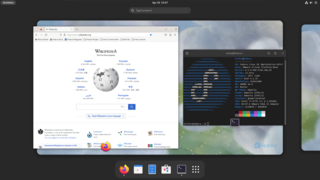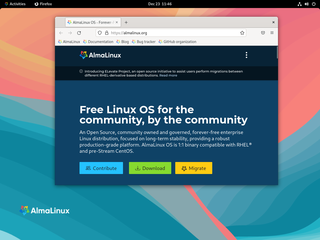The Open Archives Initiative Protocol for Metadata Harvesting (OAI-PMH) is a protocol developed for harvesting metadata descriptions of records in an archive so that services can be built using metadata from many archives. An implementation of OAI-PMH must support representing metadata in Dublin Core, but may also support additional representations.
In library and archival science, digital preservation is a formal endeavor to ensure that digital information of continuing value remains accessible and usable. It involves planning, resource allocation, and application of preservation methods and technologies, and it combines policies, strategies and actions to ensure access to reformatted and "born-digital" content, regardless of the challenges of media failure and technological change. The goal of digital preservation is the accurate rendering of authenticated content over time. The Association for Library Collections and Technical Services Preservation and Reformatting Section of the American Library Association, defined digital preservation as combination of "policies, strategies and actions that ensure access to digital content over time." According to the Harrod's Librarian Glossary, digital preservation is the method of keeping digital material alive so that they remain usable as technological advances render original hardware and software specification obsolete.
An institutional repository is an archive for collecting, preserving, and disseminating digital copies of the intellectual output of an institution, particularly a research institution. Academics also utilize their IRs for archiving published works to increase their visibility and collaboration with other academics However, most of these outputs produced by universities are not effectively accessed and shared by researchers and other stakeholders As a result Academics should be involved in the implementation and development of an IR project so that they can learn the benefits and purpose of building an IR.

DSpace is an open source repository software package typically used for creating open access repositories for scholarly and/or published digital content. While DSpace shares some feature overlap with content management systems and document management systems, the DSpace repository software serves a specific need as a digital archives system, focused on the long-term storage, access and preservation of digital content. The optional DSpace registry lists almost three thousand repositories all over the world.

Fedora is a digital asset management (DAM) content repository architecture upon which institutional repositories, digital archives, and digital library systems might be built. Fedora is the underlying architecture for a digital repository, and is not a complete management, indexing, discovery, and delivery application. It is a modular architecture built on the principle that interoperability and extensibility are best achieved by the integration of data, interfaces, and mechanisms as clearly defined modules.

Fedora Linux is a Linux distribution developed by the Fedora Project. It was originally developed in 2003 as a continuation of the Red Hat Linux project. It contains software distributed under various free and open-source licenses and aims to be on the leading edge of open-source technologies. It is now the upstream source for CentOS Stream and Red Hat Enterprise Linux.
DPubS, developed by Cornell University Library and Penn State University Libraries, is a free open access publication management software. DPubS arose out of Project Euclid, an electronic publishing platform for journals in mathematics and statistics. DPubS is free software released under Educational Community License.
EPrints is a free and open-source software package for building open access repositories that are compliant with the Open Archives Initiative Protocol for Metadata Harvesting (OAI-PMH). It shares many of the features commonly seen in document management systems, but is primarily used for institutional repositories and scientific journals. EPrints has been developed at the University of Southampton School of Electronics and Computer Science and released under the GPL-3.0-or-later license.
A digital library, also called an online library, an internet library, a digital repository, a library without walls, or a digital collection, is an online database of digital objects that can include text, still images, audio, video, digital documents, or other digital media formats or a library accessible through the internet. Objects can consist of digitized content like print or photographs, as well as originally produced digital content like word processor files or social media posts. In addition to storing content, digital libraries provide means for organizing, searching, and retrieving the content contained in the collection. Digital libraries can vary immensely in size and scope, and can be maintained by individuals or organizations. The digital content may be stored locally, or accessed remotely via computer networks. These information retrieval systems are able to exchange information with each other through interoperability and sustainability.
Lyrasis is a non-profit member organization serving and supporting libraries, archives, museums, and cultural heritage organizations around the world. Lyrasis is based in the United States. It was created in April 2009 from the merger of SOLINET and PALINET, two US-based library networks. NELINET, the New England library network, also merged into Lyrasis in late 2009. In January 2011, the Bibliographical Center for Research phased out operations and joined Lyrasis.
A library consortium is any cooperative association of libraries that coordinates resources and/or activities on behalf of its members, whether they are school, public, academic, special libraries, and/or information centers. Consortia exist on a variety of levels, e.g., local, state, regional, national or international. Libraries commonly belong to multiple consortia. The goal of a library consortium is to amplify the capabilities and effectiveness of its member libraries through collective action, including, but not limited to, print or electronic resource sharing, reductions in costs through group purchases of resources, and professional development opportunities. The “bedrock principle upon which consortia operate is that libraries can accomplish more together than alone.”

Dryad is an international open-access repository of research data, especially data underlying scientific and medical publications. Dryad is a curated general-purpose repository that makes data discoverable, freely reusable, and citable. The scientific, educational, and charitable mission of Dryad is to provide the infrastructure for and promote the re-use of scholarly research data.
Islandora is a free and open-source software digital repository system based on Drupal and integrating with additional applications, including Fedora Commons. It is open source software. Islandora was originally developed at the University of Prince Edward Island by the Robertson Library and is now maintained by the Islandora Foundation, which has a mission to, "promote collaboration through transparency and consensus building among Islandora community members, and to steward their shared vision for digital curation features through a body of software and knowledge."
DuraCloud is an open source digital preservation software originally developed by DuraSpace and maintained by LYRASIS since the merger in 2019. The DuraCloud open source software is available under the terms of the Apache License, Version 2.0. It is also available as a hosted SAAS through LYRASIS and Texas Digital Library. Users can efficiently upload content via the SyncTool, REST API, command line, and staff interface and content can be stored in Amazon Web Services S3 or Glacier services and/or Chronopolis. DuraCloud performs regular fixity checks on provides automatic error reporting. It was primarily designed to be a back-end preservation system but also has the optional ability to provide public links to content.

Ann Josephine Wolpert was an American librarian who was a pioneer in digital libraries. As director of the Massachusetts Institute of Technology Libraries from 1996 to 2013, she was instrumental in a variety of projects, including leading an initiative between MIT and Hewlett Packard to develop the DSpace digital repository system, and supporting MIT OpenCourseWare, one of the earliest large-scale projects to provide open access to university course materials. She also championed MIT's adoption of an open access mandate in 2009, the first of its kind in the United States.
MyCoRe is an open source repository software framework for building disciplinary or institutional repositories, digital archives, digital libraries, and scientific journals. The software is developed at various German university libraries and computer centers. Although most MyCoRe web applications are located in Germany, there are English-language applications, such as "The International Treasury of Islamic Manuscripts" at the University of Cambridge (UK).

Samvera, originally known as Hydra, is an open-source digital repository software product. Samvera main components are Fedora Commons, Solr, Blacklight, and HydraHead. Each Samvera implementation is called a "head".

AlmaLinux is a free and open source Linux distribution, developed by the AlmaLinux OS Foundation, a 501(c) organization, to provide a community-supported, production-grade enterprise operating system that is binary-compatible with Red Hat Enterprise Linux (RHEL). The name of the distribution comes from the word "alma", meaning "soul" in Spanish and other Latin languages. It was chosen to be a homage to the Linux community.






